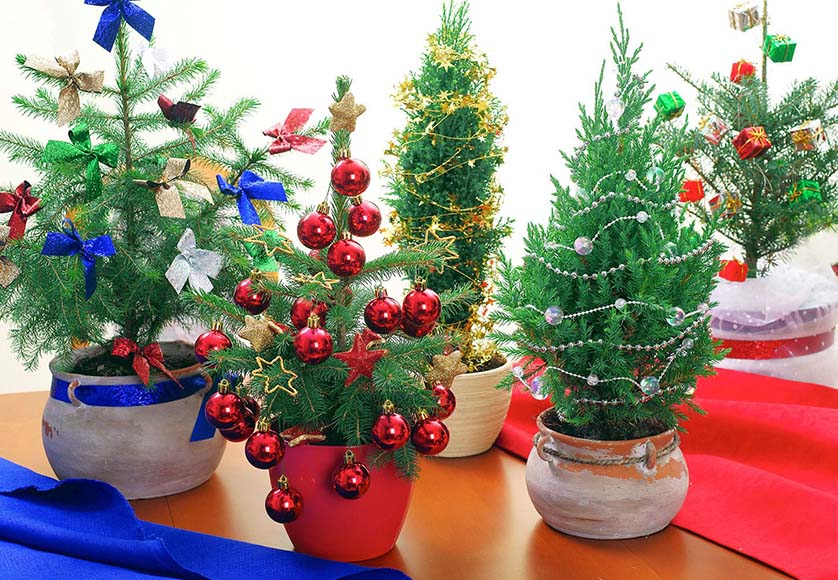Christmas gives an opportunity to bring nature into the house and enjoy the benefits of evergreen foliage.
These include indoor air-purification, avoiding waste and plastic trees, and the possibility of adding the tree to your garden post-Christmas. You could even nurture your tree in a container outside and keep it healthy and strong, ready for next Christmas.
In Portugal, the tradition of having a pine tree goes back to the 19th century. King Fernando II installed a decorated Christmas tree (to remind him of his German childhood) in 1844 in Lisbon and started the trend, much as Queen Victoria did in the UK.
However, in the past, trees were cut from the forest; nowadays this practice is no longer allowed given the environmental unsustainability it represents. Now there are commercial farms for different species that guarantee beautiful specimens and a sustainable environmental practice: for each tree felled, another is planted in its place.
Artificial trees have their fans, but there are more and more people who prefer the use of live trees, with roots, which can be replanted after the festivities. For this to be possible, do not forget that the traditional conifers and firs are outdoor plants from cold climates, so these trees are not always suitable for outside planting in our Algarve climate.
Pine, spruce and fir trees are usually on sale because they are the easiest to cultivate and the fastest to grow and they fit the traditional stereotype for a Christmas tree.
Although associated with northern Europe, bringing evergreen foliage into the house during the winter solstice predates Christianity and is one of the oldest traditions we have.
Around the Mediterranean, Ancient Egyptians brought palm leaves into their homes during the winter solstice to celebrate life’s triumph over death. At the same time, Romans would bring boughs and branches into their homes to celebrate Saturnalia in the latter half of December.
If you are unsure whether to choose a natural or artificial tree, remember, producing a plastic and metal tree is highly polluting and it cannot be recycled. In turn, after Christmas, if you cannot replant your natural tree, city councils usually collect green waste for recycling.
To escape the traditional, there are those who prefer to buy junipers (Juniperus communis) or false cypresses (Chamaecyparis lawsoniana), which provide pungent aromas and a different form of decoration. Tabletop aromatic herbs, large agave stems and bare branches can all be decorated in a festive style.
Fortunately, there are many alternatives to the evergreen conifers. Here are some suggestions for your Christmas tree this festive season.
Norfolk Island pine (Araucaria heterophylla)
This tree is perhaps the most similar to the standard Christmas tree in appearance, with its conical form and evenly spaced branches. You may have seen it growing along the coast in the Algarve as it thrives in deep sand and has a high tolerance of salt and wind. However, the young trees are also very suitable for indoors and are often grown in pots as houseplants. These trees suffer in prolonged periods of cold and prefer bright, mostly indirect light. They require little maintenance, surviving indoors for years until ready to be planted outside.
Weeping fig (Ficus benjamina)
This is a popular house plant and can reach a good size indoors. Maybe you already have one as a house plant and can transform its appearance for the festive season with decorations and lights.
Butterfly palm (Chrysalidocarpus lutescens)
This has masses of upright, divided leaves. This is bound to look very different to a traditional tree. For a similar look, you could try Howea fosteriana (Kent palm) or Chamaedorea elegans (Parlour Palm), which have slightly larger leaflets. Grow in bright light out of direct sunlight, water well when in active growth and mist regularly.
Fern Pine (Podocarpus gracilior)
A medium-sized, slow-growing tree making a column shape. It has soft weeping bushy foliage with a rich, deep green colour and branches that will droop over time. It is low maintenance and resistant to pests and diseases, can handle mild drought and is salt tolerant.
Cypress
Columnar and pyramidal forms are good evergreens. If you can, find a good shape tree that will fit your space indoors. These will make the move into the garden with little stress.
Some tips to ensure you have a beautiful and healthy specimen
- Plan, before buying, where you will place your tree and keep away from heat sources. Remember that the best place will be with indirect sunlight and in a dry environment, but with the root (or cut trunk) slightly damp. Check also that it is not near a heavily used access between rooms and there is a plug nearby for lights.
- Measure the space for your tree and make sure that the specimen you choose is at least 30cm lower than the ceiling so that you can put the star on top! Make a note of the space available and take a tape measure, especially if you need to get it into your car!
- Check for good health. If you pull a branch and needles fall, choose another specimen. Make sure the needles are green and shiny and not dull or dry. Don’t take home a diseased or infested tree. Check it does not smell musty and confirm that your needles and trunks do not have spots or stains.

Scculents tree
If you buy a tree with a cut trunk (without roots), make sure you saw off about 2cm from the base so that it can absorb more water and stay beautiful for longer. Also ensure that the foot of the trunk is cut straight across so that it has solid support before decorating.
Enjoy your evergreen foliage of whatever type and have a wonderful festive season.
With grateful thanks to Jardins magazine https://revistajardins.pt/
By Rosie Peddle
|| features@algarveresident.com
289 791 869 | mgapsec@gmail.com
facebook.com/MedGardenersPortugal
www.mgaportugal.org




















